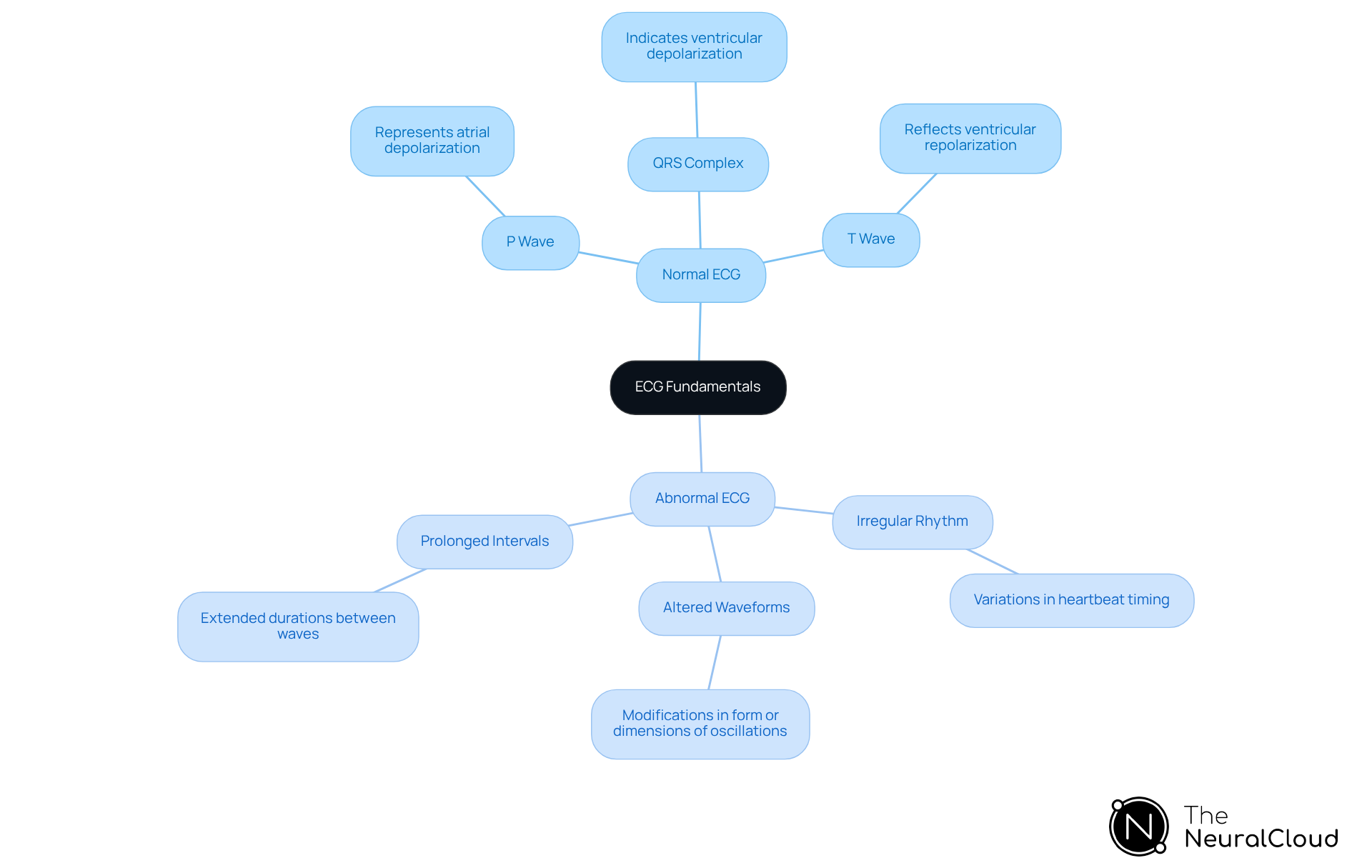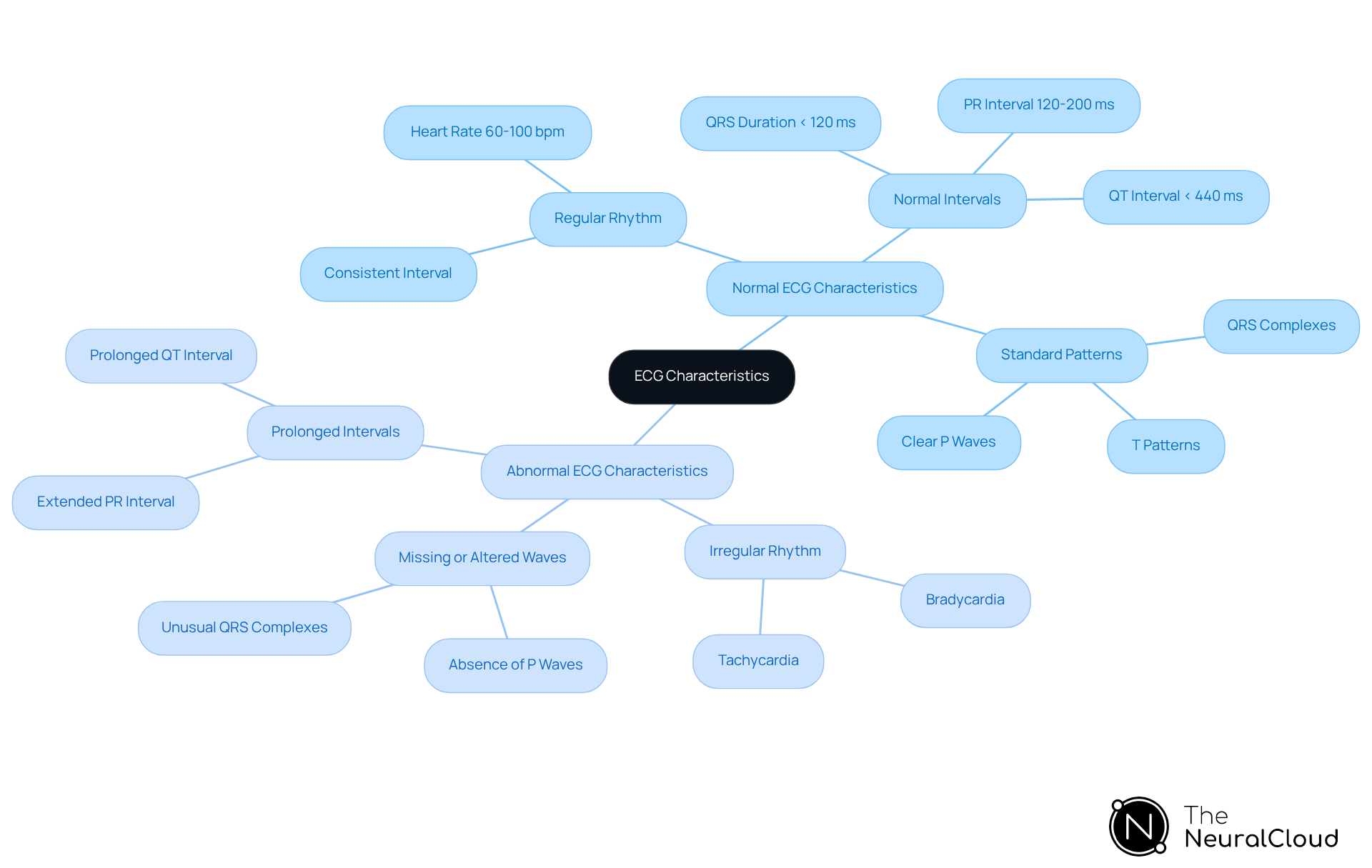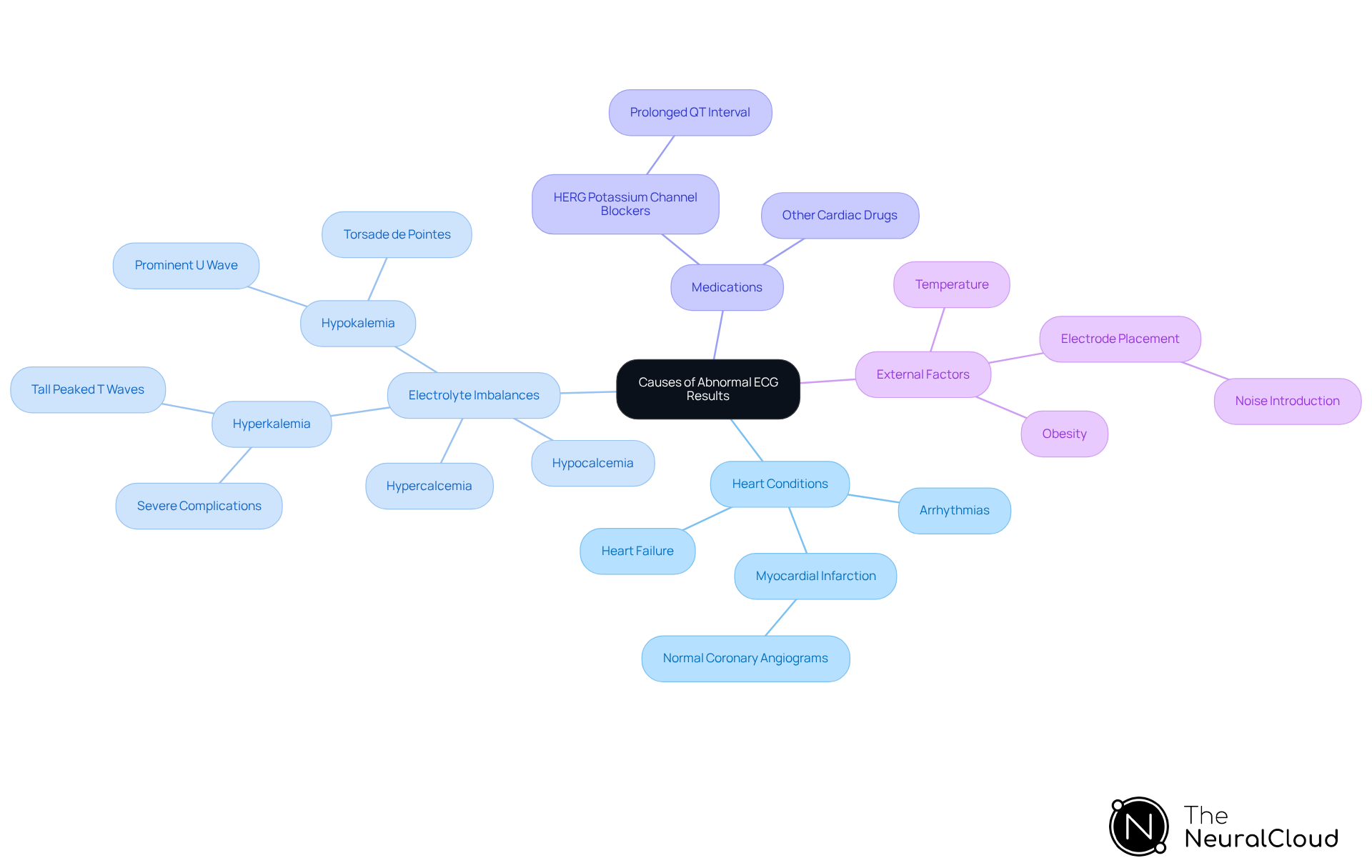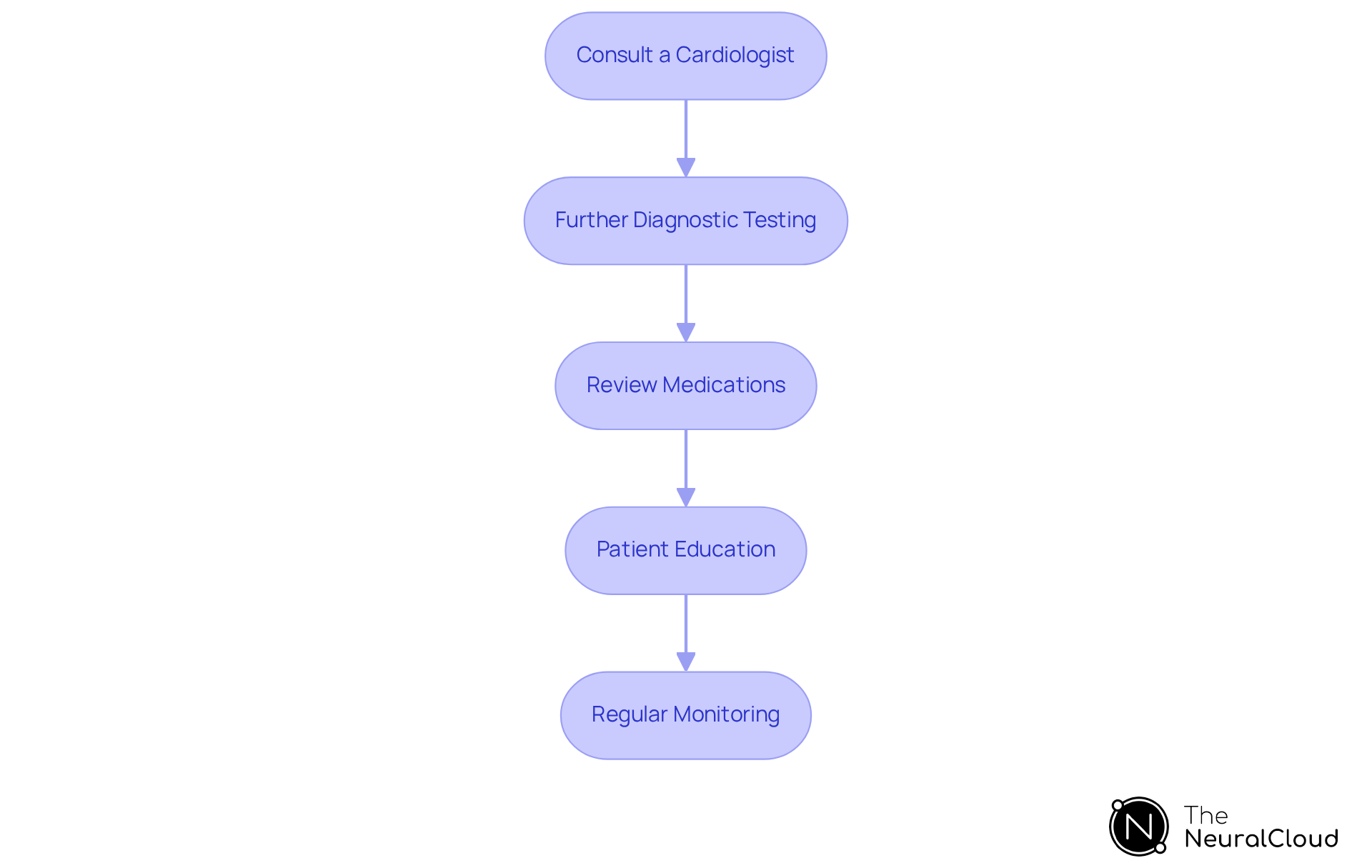Overview
Understanding abnormal ECG readings is crucial for effective patient management. This involves recognizing their causes, characteristics, and necessary follow-up steps. Abnormal ECGs can arise from various heart conditions, electrolyte imbalances, medications, and external factors. Accurate interpretation is essential, as it informs subsequent actions, such as:
- Consulting a cardiologist
- Conducting further diagnostic tests
These steps are vital to ensure optimal patient care.
Introduction
Abnormal ECG readings can evoke anxiety and confusion among patients and healthcare professionals. These readings, which may indicate serious underlying conditions, are not isolated incidents; they reflect a complex interplay of heart health, external factors, and the nuances of medical technology. This article explores the critical differences between normal and abnormal ECG patterns, examines the various causes of these irregularities, and outlines essential next steps for effective patient management.
How can healthcare providers ensure accurate interpretation and timely intervention amid these complexities? Understanding these dynamics is vital for improving patient outcomes and navigating the intricacies of cardiac care.
Clarify ECG Fundamentals: Normal vs. Abnormal Readings
An electrocardiogram (ECG) captures the heart's electrical activity over time, providing critical insights into cardiac health. A typical ECG displays a steady arrangement of signals: P signals, QRS complexes, and T signals, each indicating separate stages of the cardiac cycle. In contrast, an abnormal ECG reading may reveal irregularities such as absent signals, altered intervals, or unusual shapes. For instance, a prolonged QT interval can signal potential heart rhythm problems, while inverted T patterns may suggest ischemia. Understanding these fundamentals is crucial for healthcare practitioners to precisely evaluate cardiac issues, particularly when employing sophisticated tools like Neural Cloud Solutions' MaxYield™ platform, which enhances ECG analysis efficiency through advanced noise filtering and signal recognition techniques.
MaxYield™ rapidly isolates and labels critical data from recordings, even amidst significant noise and artifacts. By transforming noisy recordings into detailed insights, MaxYield™ delivers beat-by-beat analysis, outputting an analysis of 200,000 heartbeats in less than 5 minutes. This capability empowers healthcare professionals to identify cardiac events more confidently, supporting timely and accurate clinical decisions. Furthermore, MaxYield™ addresses challenges in ECG interpretation, such as physiological variability and signal artifacts, ensuring a more reliable analysis.
Key Components of a Normal ECG:
- P Wave: Represents atrial depolarization.
- QRS Complex: Indicates ventricular depolarization.
- T Wave: Reflects ventricular repolarization.
Characteristics of Abnormal ECGs:
- Irregular Rhythm: Variations in heartbeat timing can suggest underlying issues.
- Altered Waveforms: An abnormal ECG reading may indicate modifications in the form or dimensions of the oscillations, suggesting pathology.
- Prolonged Intervals: Extended durations between waves can suggest an abnormal ECG reading due to conduction problems.
In clinical practice, studies show that around 10-15% of ECG readings are considered abnormal ECG readings, emphasizing the significance of precise interpretation. Real-world examples of ECG interpretation often involve identifying conditions such as atrial fibrillation or myocardial infarction, where timely diagnosis can significantly impact patient outcomes. With the integration of MaxYield™, understanding the nuances of normal versus irregular ECG readings becomes more efficient, ultimately .

Identify Key Differences: Characteristics of Normal and Abnormal ECGs
To effectively differentiate between normal and abnormal ECGs, healthcare professionals should concentrate on specific characteristics:
Normal ECG Characteristics:
- Regular Rhythm: A consistent interval between beats, typically ranging from 60 to 100 beats per minute.
- Standard Patterns: Clear P waves followed by QRS complexes and T patterns, indicating proper electrical conduction.
- Normal Intervals: The PR interval should be between 120 and 200 milliseconds, the QRS duration should be less than 120 milliseconds, and the corrected QT interval should be under 440 milliseconds.
Abnormal ECG Characteristics:
- Irregular Rhythm: Variability in heart rate, which may present as bradycardia (a slow heart rate) or tachycardia (a fast heart rate).
- Missing or Altered Waves: The absence of P waves or the presence of unusual QRS complexes can indicate conditions such as atrial fibrillation or ventricular hypertrophy.
- Prolonged Intervals: Extended PR or QT intervals may signal conduction blocks or an increased risk of arrhythmias, necessitating further evaluation.
Understanding these characteristics is crucial, as can signal serious underlying conditions, including arrhythmias, which are common in the general population. For instance, research indicates that around 2-3% of adults experience atrial fibrillation, a prevalent irregular rhythm that can result in serious health issues if not adequately managed.
Neural Cloud Solutions' MaxYield™ platform enhances ECG analysis efficiency by employing advanced noise filtering and distinct wave recognition. This allows healthcare professionals to rapidly isolate ECG waves, even in recordings with high levels of noise and artifact. Such capability is essential for salvaging previously obscured sections of lengthy Holter, 1-Lead, and patch monitor recordings. The MaxYield™ algorithm evolves with each use, continuously improving its accuracy and efficiency in pursuit of maximum diagnostic yield.
Accurate ECG rhythm analysis is vital, as timely identification of abnormal ECG readings can lead to improved patient outcomes and more effective treatment strategies. Furthermore, it is essential to recognize that anxiety can also influence pulse rate and rhythm, potentially resulting in unusual ECG readings. The non-invasive nature of ECGs makes them a safe and essential tool in clinical practice.

Explore Causes of Abnormal ECG Results: From Heart Conditions to External Factors
[Abnormal ECG readings](https://theneuralcloud.com/post/10-key-artefact-ecg-issues-and-their-solutions) can arise from a variety of causes, ranging from heart conditions to external influences. Common causes of abnormal ECGs include:
- Heart Conditions: Conditions such as arrhythmias, myocardial infarction, and heart failure can lead to significant changes in ECG patterns. For instance, approximately 5% of patients experiencing a myocardial infarction may present with normal coronary angiograms, indicating underlying issues that can affect ECG readings.
- Electrolyte Imbalances: Abnormal levels of potassium, calcium, or magnesium can critically impact heart rhythm and conduction, resulting in an abnormal ECG reading. Hypokalemia, the most prevalent electrolyte imbalance, is characterized by a significant U deflection on the ECG, which can result in an abnormal ECG reading and lead to severe arrhythmias such as torsade de pointes ventricular tachyarrhythmia. Conversely, hyperkalemia may present as elevated, pointed T shapes, and an abnormal ECG reading may indicate serious complications occurring at potassium levels surpassing 10.0 mmol/L.
- Medications: Certain drugs, particularly those affecting heart rate or rhythm, can result in an abnormal ECG reading. For example, medications that suppress the HERG potassium channel may lead to prolonged action potential duration and QT interval, especially in the presence of hypokalemia.
- External Factors: Conditions such as obesity, temperature, and even electrode placement can impact the accuracy of ECG readings. Improper electrode placement can introduce noise, leading to misinterpretation of the ECG. Notably, individuals with a BMI classified as overweight are at a significantly higher risk of developing cardiovascular disease, which can further complicate ECG interpretations.
Understanding these factors is crucial for healthcare professionals, as they can significantly influence the accuracy and reliability of abnormal ECG readings, which ultimately affects patient care. With the , these challenges can be addressed effectively. The platform's advanced noise filtering and distinct wave recognition capabilities allow for the rapid isolation of ECG waves from recordings that may be compromised by baseline wander, movement, and muscle artifact. This transformation of lengthy and noisy ECG recordings into clean, crisp signals enhances the accuracy and reliability of readings, ultimately improving patient care.

Determine Next Steps: Navigating Follow-Up Actions After Abnormal ECG Findings
After recognizing an abnormal ECG reading, it is essential to take suitable follow-up actions for ensuring patient safety and effective management. The recommended next steps are as follows:
- Consult a Cardiologist: Referral to a specialist is often necessary, particularly for significant abnormalities. Research indicates that a significant proportion of patients require following an abnormal ECG reading, underscoring the necessity of professional assessment.
- Further Diagnostic Testing: Additional tests, such as echocardiograms, stress tests, or Holter monitoring, may be recommended to gather more comprehensive information about the patient's cardiac health. This step is crucial for diagnosing underlying conditions that may not be evident from the ECG alone.
- Review Medications: Assess current medications that could influence ECG results. Some medications, such as beta-blockers, can result in unusual readings, and modifications may be required to guarantee precise monitoring of cardiovascular well-being.
- Patient Education: Inform patients about the implications of their ECG results and the importance of follow-up care. Discussing lifestyle changes, such as diet and exercise, empowers patients to enhance their cardiovascular health and mitigate risks linked to unusual results.
- Regular Monitoring: Schedule follow-up appointments to monitor the patient's condition and response to any interventions. Regular monitoring is essential, as timely intervention can significantly enhance outcomes for patients with abnormal ECG readings.
In practical situations, cardiologists frequently suggest additional testing based on abnormal ECG readings, which leads to prompt actions that can avert serious complications, such as cardiac arrests. Consulting a cardiologist is not merely a precaution; it is a critical step in navigating the complexities of heart health.

Conclusion
Understanding abnormal ECG readings is essential for accurate cardiac assessment and timely intervention. This article has explored the fundamental differences between normal and abnormal ECGs, the various causes of abnormal results, and the critical next steps that healthcare professionals should take to ensure patient safety and effective management.
Key points discussed include the essential characteristics of normal ECGs, such as regular rhythms and standard wave patterns, contrasted with the irregularities often found in abnormal readings. Factors contributing to abnormal ECG results include:
- Heart conditions
- Electrolyte imbalances
- Medications
- External influences
These factors highlight the complexities involved in ECG interpretation. Additionally, the integration of advanced tools like Neural Cloud Solutions' MaxYield™ platform significantly enhances the accuracy and efficiency of ECG analysis, enabling healthcare providers to make informed decisions swiftly.
Ultimately, recognizing and addressing abnormal ECG readings is vital for improving patient outcomes and ensuring effective treatment strategies. By consulting specialists, conducting further diagnostic tests, and educating patients on the importance of follow-up care, healthcare professionals can navigate the complexities of cardiac health more effectively. Emphasizing the significance of accurate ECG interpretation and proactive management can lead to better health outcomes and a more robust understanding of cardiovascular conditions.
Frequently Asked Questions
What is an electrocardiogram (ECG)?
An electrocardiogram (ECG) captures the heart's electrical activity over time, providing critical insights into cardiac health.
What are the main components of a normal ECG?
A normal ECG typically displays three key components: the P wave (representing atrial depolarization), the QRS complex (indicating ventricular depolarization), and the T wave (reflecting ventricular repolarization).
What indicates an abnormal ECG reading?
An abnormal ECG reading may reveal irregularities such as absent signals, altered intervals, unusual shapes, irregular rhythms, altered waveforms, or prolonged intervals between waves.
What does a prolonged QT interval signify?
A prolonged QT interval can signal potential heart rhythm problems.
How does the MaxYield™ platform enhance ECG analysis?
MaxYield™ enhances ECG analysis by rapidly isolating and labeling critical data from recordings, even amidst significant noise and artifacts, allowing for beat-by-beat analysis of 200,000 heartbeats in less than 5 minutes.
What challenges in ECG interpretation does MaxYield™ address?
MaxYield™ addresses challenges such as physiological variability and signal artifacts, ensuring a more reliable analysis of ECG readings.
What percentage of ECG readings are considered abnormal?
Studies show that around 10-15% of ECG readings are considered abnormal.
Why is precise interpretation of ECG readings important?
Precise interpretation is crucial because timely diagnosis of conditions like atrial fibrillation or myocardial infarction can significantly impact patient outcomes.
How does MaxYield™ improve understanding of normal vs. abnormal ECG readings?
By integrating advanced noise filtering and signal recognition techniques, MaxYield™ makes understanding the nuances of normal versus irregular ECG readings more efficient, enhancing cardiac assessment and intervention.






